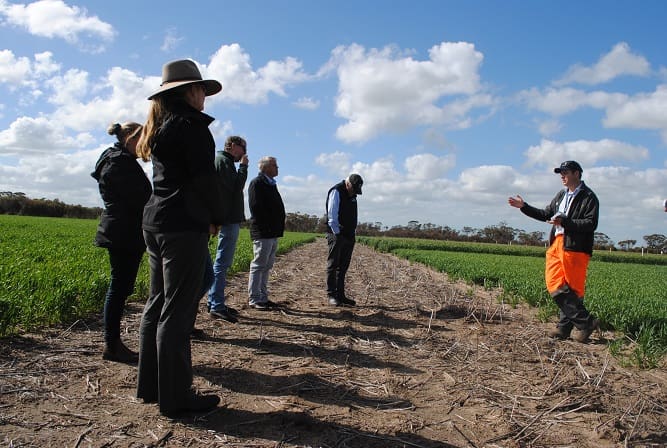WESTERN Australian research has confirmed barley is better than wheat when getting the best from early sown crops in frost-prone landscapes.

DPIRD senior research officer Ben Biddulph discusses frost at a field tour in Quairading. (Photot: GRDC)
WA Department of Primary Industries and Regional Development (DPIRD) trials at medium production zones (Kulin-Lake Grace and Quairading) and high production zones (Wickepin and Dale), examined the performance of longer season varieties of wheat, barley and oats impacted by frost.
DPIRD senior research officer Ben Biddulph said barley was better able to maintain grain yield and gross income than wheat in all sowing windows from mid-April to mid-May, under moderate and severe frost.
“Under moderate frost environments longer season barley varieties sown in early to late May produced the highest grain yield and gross income of all crop types evaluated,” Dr Biddulph said.
“Under severe frost, long season oats were able to maintain higher grain yield and gross income compared to barley. However, the lower historical price and lower grain yield potential in low rainfall environments of oats relative to barley, reduces their usefulness as a frost management tool.”
In the higher production environments and seasons at Wickepin and Dale, longer season strong and mild PPD (photoperiod) responsive wheats such as Forrest, sown in early May, and the mid-long varieties such as Cutlass, sown in late May, were able to maintain grain yield, quality and gross income competitive with barley in mild frost environments.
In early June, mid season wheat varieties such as Scepter generally produced the highest gross margin of the wheats available.
“Optimising crop and variety choice at sowing time to minimise frost exposure is still the most important way farmers can minimise frost damage,” Dr Biddulph said.
He said growers should be mindful of the opportunity cost of sowing mid-season varieties of all crop types in late April and early May, as they did not optimise grain yield and quality compared to mid and late May sown crops.
“Growers should consider planting longer season oats, barley and then longer maturity wheat varieties when early opportunity arises, rather than the commonly used mid-season varieties.
“This will ensure adequate biomass is accumulated both above and below ground, and can be converted into grain yield, while managing frost risk. This may also reduce the potential opportunity cost associated with lower yield and greater frost damage in seasons when frost occurs and affects grain yield and quality.
“In high and medium production environments, sowing oats and barley in late-April to mid-May, and then mid-long wheats in late May, is still the management practice which achieves the highest gross income in frost prone environments.”
Source: GRDC

HAVE YOUR SAY